from obsessed with frida kahlo
[youtube=http://www.youtube.com/watch?v=_RrS5xvfRXg]
no sos frida kahlo, 2007
[youtube=http://www.youtube.com/watch?v=dsHCjxKoYc4]
puppets, 2007

from obsessed with frida kahlo
[youtube=http://www.youtube.com/watch?v=_RrS5xvfRXg]
no sos frida kahlo, 2007
[youtube=http://www.youtube.com/watch?v=dsHCjxKoYc4]
puppets, 2007

My newest partner in crime is the talented, witty, godzilla and pikapika lovin' Chicano artist and curator Rio Yañez. I first came across his Ghetto Frida two years ago, while working on the project Obsessed With Frida Kahlo. Immediately I felt some sort of cosmic connection-not to Ghetto Frida- but to her creator. And then to make matters worse better, I found out that he is the son of one my biggest heroes- Yolanda Lopez!There was really no option other than collaboration. It was fate.Last month we finally initiated our long distance partnership through a tweet. Since then we have been communicating through TwitPic, Facebook, YouTube, phone calls and texts, and of course mutual shouts in interviews on the blogosphere (mine to Rio & Rio's to me.)Here are a few examples of Rio's recent work:
"I’ve been twittering for about a week now at http://twitter.com/rioyanez. I signed up as a way to contact Amber Rose after she started writing and posting about the portrait I created of her. I have to say, the most exciting aspect of twitter is the way people distribute images. The short urls for twitpics that often pop up on tweets evoke a sense of curiosity in me; more so than the many thumbnails that can be found on facebook. I think the lack of a thumbnail is more alluring and it forces you to chose to see the image or not, there’s no middle ground of a provided preview." (from his blog)
"Artist Curator Rachel-Anne Palacios flanked by Zitlalix and I. I created this portrait to thank Rachel for including me in the recent Frida exhibit she curated and to join the many artists who are on display on the walls of her apartment" (from flickr)
These images represent my first foray into my Raza Zombies series. They were inspired by the single best mainstream comic book of the 21st century: Marvel Zombies. Marvel Zombies re-imagines classic superheroes as flesh eating zombies. After reading it I felt compelled to do some zombie transformations on a few of my own personal heroes. More to come. (from flickr)[youtube=http://www.youtube.com/watch?v=1AhRQrJ7ePg]
Video of Gomez Peña setting the record straight for Rio regarding his Facebook presence.
[youtube=http://www.youtube.com/watch?v=QycIf6uKRd0]
Rio's Ghetto Frida Mural in the Mission District
stay tuned for more...

photo by Gina Grafos
Hello blogosphere!So it is a new year and a new beginning... Loren and I have spent the last 3 months in happy newly wed bliss. He is kicking butt in law school and it seems his band Cavalry is getting more and more attention everyday. I have a number of really exciting projects on the horizon- all collaborations- which I plan to blog about in the months to come.It feels good to be back.Maya
I was interviewed on the Latino Blog Directory site Blogaderaclick here for full interview:
 [more]check out other Blogadera interviews with Carrie Fergerson and Jo Ann Hernandez
[more]check out other Blogadera interviews with Carrie Fergerson and Jo Ann HernandezI promise to come back soon. I just needed a moment to pause and re-collect.Maya
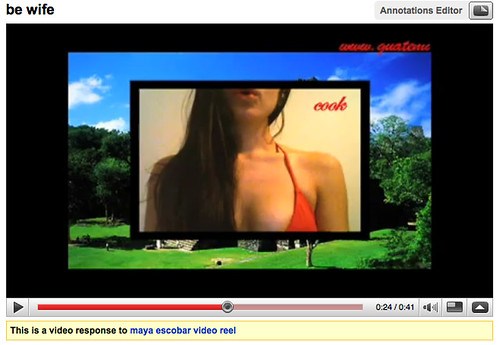
In October of 2006 my rabbi started blogging. While trying to comment on one of his posts, I accidentally registered my own blog. Within hours of posting a comment, my name began appearing in Google searches. I was now linked to the post I had commented on, previous posts my rabbi had written, comments left by other users and the posts they had written elsewhere within the blogosphere. The rapidity with which I was branded, not only by my own online activity, but also by the online activity of others, seemed incomprehensible.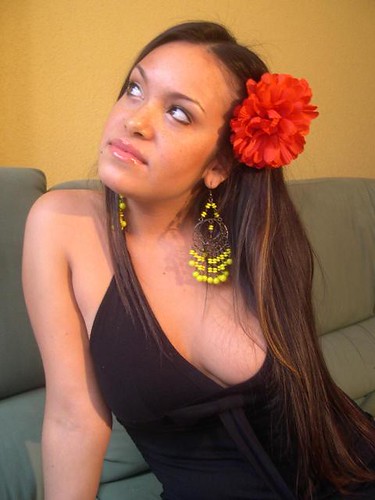 I thought about this phenomenon in relationship to, the images that my friends and I had posted on Myspace throughout that year. I unknowingly went from being slightly annoyed and simultaneously amused by the phrase "take a picture of me for my Myspace", to it becoming completely natural and almost organic to document every moment, every outing, every time my friends and I put on make up, and to take pictures for Myspace. I saw this behavior even further exaggerated in the high school students I was student teaching. Their conversations were dominated with events that had transpired on Myspace, and when they were not talking about Myspace they were taking pictures for Myspace.When we talked about the factors that contributed to the construction of their individual and collective identities, my students were quick to bring up their style of dress, group of friends, the neighborhood they lived in, and the way they spoke. Yet not a single student referenced their online activity, the pictures they posted, the groups they joined, the comments they left on each others pages. I wondered why it was, that they were so aware of and adept at reflecting upon their experiences in the material offline world, but failed to mention the social network that played such a major role in their day-to-day lives.DECONSTRUCTING PERSONAL IDENTITY
I thought about this phenomenon in relationship to, the images that my friends and I had posted on Myspace throughout that year. I unknowingly went from being slightly annoyed and simultaneously amused by the phrase "take a picture of me for my Myspace", to it becoming completely natural and almost organic to document every moment, every outing, every time my friends and I put on make up, and to take pictures for Myspace. I saw this behavior even further exaggerated in the high school students I was student teaching. Their conversations were dominated with events that had transpired on Myspace, and when they were not talking about Myspace they were taking pictures for Myspace.When we talked about the factors that contributed to the construction of their individual and collective identities, my students were quick to bring up their style of dress, group of friends, the neighborhood they lived in, and the way they spoke. Yet not a single student referenced their online activity, the pictures they posted, the groups they joined, the comments they left on each others pages. I wondered why it was, that they were so aware of and adept at reflecting upon their experiences in the material offline world, but failed to mention the social network that played such a major role in their day-to-day lives.DECONSTRUCTING PERSONAL IDENTITY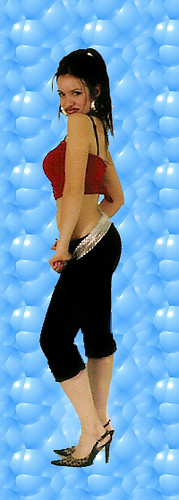 (today) I am referring to myself as a performance artist, Internet curator, and editor. I create and (concurrently) perform multiple online identities, by sampling from different representations of existing cultural discourses. I fragment my personal experiences and invite others to join in, and modify and regroup those fragments. By doing this I hope to share the process through which I deconstruct and reconstruct my individual conception of self, so that others can do the same in their lives.In the series Acciones Plásticas I performed representations of five constructed characters: a religious Jewish woman, a spoiled Jewish girl, a ghetto Latina, a sexy Latina professor, and a Mayan woman. I created low quality YouTube video blogs for four of the characters, the Mayan woman did not have a video, as she would not have had access to YouTube technologies. The videos were strategically placed on popular social networking sites, including YouTube and MySpace. The layout of YouTube contextualized the videos and framed them with user comments and similarly tagged user content. Jewish Girls was picked up by a popular left-wing Jewish blogging site Jewschool, and soon entered the Jewish Blogosphere where it was referred to as the JAP. This repositioning shifted the focus from the portrayal of multiple interwoven identities to a depiction of the Jewish American Princess. The JAP became how people knew my work, validating me while simultaneously conflating my identity with that of this particular character.
(today) I am referring to myself as a performance artist, Internet curator, and editor. I create and (concurrently) perform multiple online identities, by sampling from different representations of existing cultural discourses. I fragment my personal experiences and invite others to join in, and modify and regroup those fragments. By doing this I hope to share the process through which I deconstruct and reconstruct my individual conception of self, so that others can do the same in their lives.In the series Acciones Plásticas I performed representations of five constructed characters: a religious Jewish woman, a spoiled Jewish girl, a ghetto Latina, a sexy Latina professor, and a Mayan woman. I created low quality YouTube video blogs for four of the characters, the Mayan woman did not have a video, as she would not have had access to YouTube technologies. The videos were strategically placed on popular social networking sites, including YouTube and MySpace. The layout of YouTube contextualized the videos and framed them with user comments and similarly tagged user content. Jewish Girls was picked up by a popular left-wing Jewish blogging site Jewschool, and soon entered the Jewish Blogosphere where it was referred to as the JAP. This repositioning shifted the focus from the portrayal of multiple interwoven identities to a depiction of the Jewish American Princess. The JAP became how people knew my work, validating me while simultaneously conflating my identity with that of this particular character.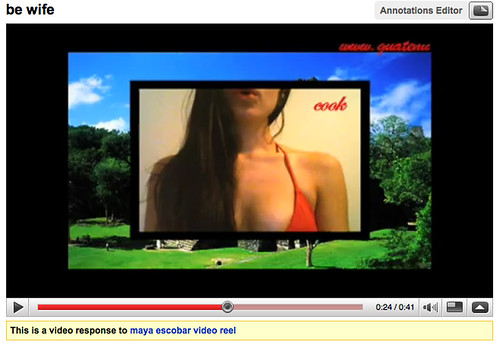 One of the strategies that I employed to counteract idea of "me as The JAP" was to group videos from the series Acciones Plásticas together with three other Youtube videos in a video reel of my work. The first video in the reel, el es frida kahlo is me dressed as Frida Kahlo where I violently scream I am Frida Kahlo! In second video Be Wife, I wear a bright red bikini top in front of an image of a Mayan temple in Tikal. Traditional Guatemalan marimba music plays in the background, while red text scrolls across the top reading Guatemala's finest export. The third video Que Sencilla, features me as a little girl, who is being coaxed by an off-camera male voice to perform a dance for the camera.Someone who is expecting to see a Jewish American Princess, is instead greeted with an enraged
One of the strategies that I employed to counteract idea of "me as The JAP" was to group videos from the series Acciones Plásticas together with three other Youtube videos in a video reel of my work. The first video in the reel, el es frida kahlo is me dressed as Frida Kahlo where I violently scream I am Frida Kahlo! In second video Be Wife, I wear a bright red bikini top in front of an image of a Mayan temple in Tikal. Traditional Guatemalan marimba music plays in the background, while red text scrolls across the top reading Guatemala's finest export. The third video Que Sencilla, features me as a little girl, who is being coaxed by an off-camera male voice to perform a dance for the camera.Someone who is expecting to see a Jewish American Princess, is instead greeted with an enraged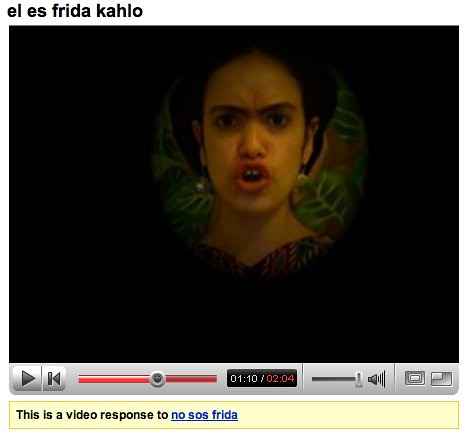 Latina artist, trying to fight the stigma of being associated with Frida Kahlo. My inclusion of these additional videos was to show the multidimensionality of the five characters initially presented in Acciones Plásticas. The Mayan women does not have her own YouTube video, but with the addition of the Be Wife video, her absence is felt even greater. The face of Guatemala in these videos, is the chest of a mail order bride. Another example can be seen within the four original videos themselves. With the grouping of the ghetto latina with the sexy latina professor, vast cultural and class difference can be seen between the two representations of Latina women. Put together with el es frida kahlo and Be Wife, there are suddenly five Latina performers all acting on one stage.
Latina artist, trying to fight the stigma of being associated with Frida Kahlo. My inclusion of these additional videos was to show the multidimensionality of the five characters initially presented in Acciones Plásticas. The Mayan women does not have her own YouTube video, but with the addition of the Be Wife video, her absence is felt even greater. The face of Guatemala in these videos, is the chest of a mail order bride. Another example can be seen within the four original videos themselves. With the grouping of the ghetto latina with the sexy latina professor, vast cultural and class difference can be seen between the two representations of Latina women. Put together with el es frida kahlo and Be Wife, there are suddenly five Latina performers all acting on one stage.
Jewish Girls from the series Acciones Plásticas
[youtube=http://www.youtube.com/watch?v=GBjBN0ftcP0]Responses to Jewish Girls
[youtube=http://www.youtube.com/watch?v=PQphBV2Q0ZE]
[youtube=http://www.youtube.com/watch?v=bGjJhIFUNGA][youtube=http://www.youtube.com/watch?v=CycyYiY933A][youtube=http://www.youtube.com/watch?v=yCM4rrhbj5U]click here to visit website
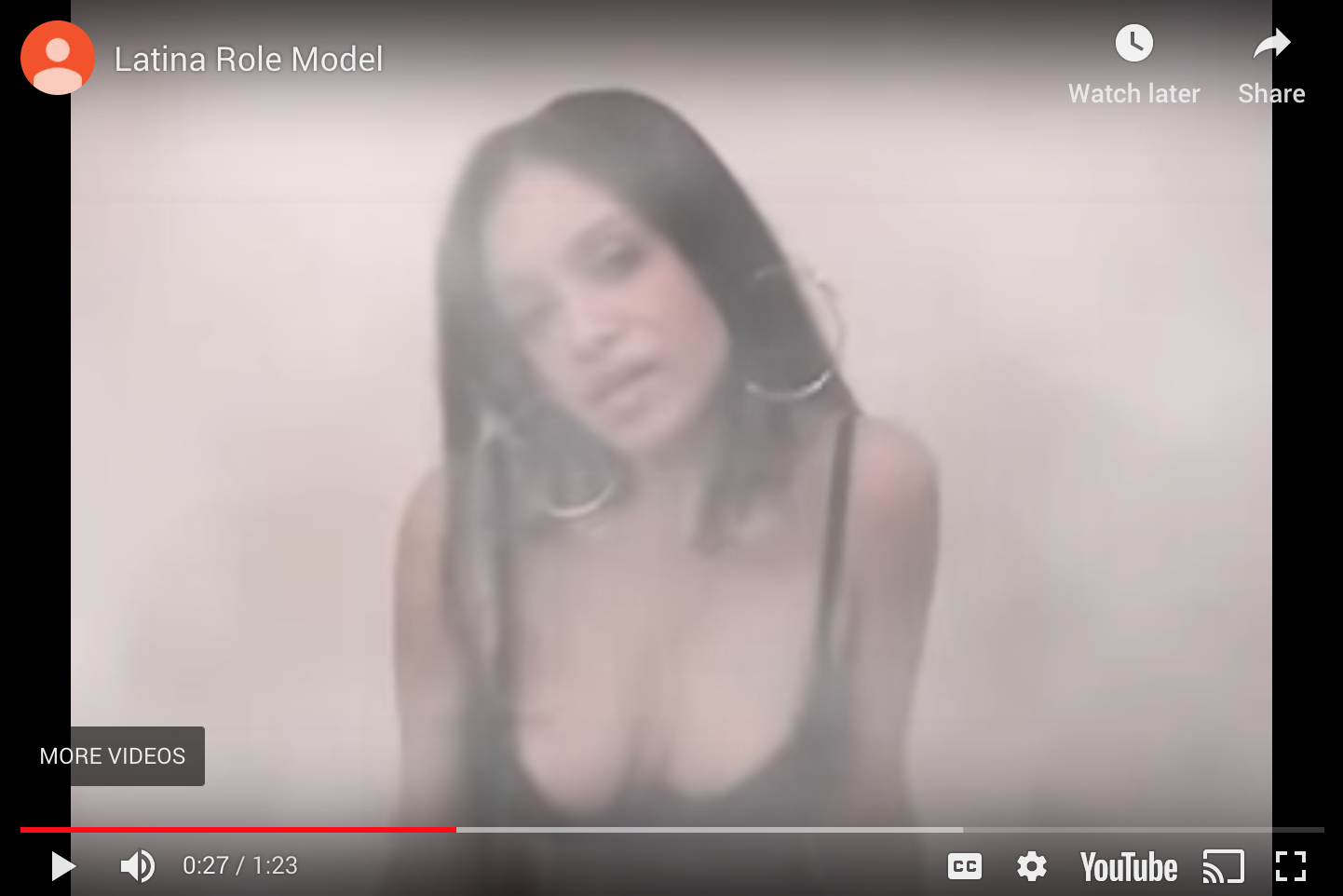
Por David Sperber en Ma’arav Israeli Arts and Culture MagazineTraducción de Gonzalo Escobar (de Traducción de Shlomit Nehorai)Maya Escobar es sin ninguna duda una de las personas más de moda en el desarrollo del arte judío-estadounidense. Escobar se define como “artista disléxica del Internet”. Y para ver su trabajo uno no necesita ir muy lejos.Su trabajo es creado principalmente en el formato familiar del Internet, y se puede ver más frecuentemente en Youtube. Escobar es hija de madre Judía y de padre Guatemalteco, ella define su trabajo personal y versátil de arte como una investigación antropológica-sociológica dentro de la narrativa que utiliza medios electrónicos contemporáneos.Acciones Plásticas incluye películas de corto metraje que presentan una serie de caracteres persuasivos y monólogos en los que se cuestiona la identidad. En la primera película de corto metraje de la serie aparece, vestida como la artista mexicana Frida Kahlo quien se convirtió en un ícono dentro del discurso feminista. Se argumenta comúnmente que Kahlo tenía algunas raíces judías. Escobar aparece vestida como Kahlo con sus famosas cejas mientras que grita “Yo soy Frida Kahlo. Usted es Frida Kahlo. Nosotros somos Frida Kahlo”. En agitación o en éxtasis se desgarra su ropa, se despeina, se quita el maquillaje y vuelve a ser ella misma.[youtube=http://www.youtube.com/watch?v=xlMPoFXRT18]
En la otra película de corto metraje de la serie, ella continúa con un monólogo de una mujer ortodoxa judía. El texto aquí es tan exacto que por un minuto la línea entre la ironía y la comedia burda y la seriedad profunda es borrosa.[youtube=http://www.youtube.com/watch?v=8H8mpau6dSc]En otra película de corto metraje se presenta el estereotipo de mujer latina como objeto sensual sexual, cuando aquí el tema se desenvuelve también entre la aprobación y la destrucción de los estereotipos. Escobar presenta diversos episodios basados en la realidad que ella misma ha experimentado enfocados en su identidad híbrida como mujer, como judía y como latinoamericana.[youtube=http://www.youtube.com/watch?v=F_1X1igrL4U]Otro trabajo de Escobar es My Shtreimel (Mi sombrero de peluche judío de Europa Oriental) - un vídeo-blog que también se puede encontrar en Youtube. En esta sección aparece un joven de más de veinte años que está sentado frente a una computadora y habla de sus rituales del Shabbat (el día de descanso para los judíos). El monólogo describe un mundo judío amorfo en el cual la esencia judía viva y material no es obligatoria a sus instituciones, sobre todo en el marco personal. Una parte central en este mundo es la auto depreciación de uno mismo: El joven muestra su querido shtreimel y menciona que el shtreimel que se ve como el sombrero tradicional es realmente un sombrero de mujer comprado en una tienda de segunda.
En el trabajo “eruv”* (entremezclarse) Escobar relata el hecho que en Berlín no hay ningún eruv aun cuando allí existe una comunidad judía vibrante. En una serie de entrevistas fotografiadas con los habitantes de la ciudad ella transforma la noción del eruv - en una noción legal halajá (recopilación de las principales leyes judías) que crea una transformación del espacio público en el espacio privado, en una mezcla - la creación múltiple de caracteres y de mundos. El eruv se transforma en un concepto cultural que celebra lo diferente y lo único. Los individuos crean un mosaico espléndido que ensambla un grupo “colectivo” diferente como concepto social. La forma en que Escobar trata el tema es típico al mundo judío-estadounidense del arte que tiende a transferir los conceptos del halajá práctico y para transferirlo a otro mundo, y así se transforma en una metáfora de la condición personal o social. La experiencia personal es significativa a Escobar. Como otros rituales judíos, el Shabbat abarca los sentidos prácticos que materializan la condición privada en un espacio privado. Excepto que el entendimiento del espacio privado y del espacio público es fluido y cambia siempre. Yo pienso que es muy importante de que la gente celebre su Shabbat como experiencia agradable, definida y personal. Los rituales del Shabbat evolucionan con el tiempo - no como obligación inamovible que se transfiere de generación en generación, pero como resultado de una opción simple del individuo de crear él/ella las mismas costumbres agradables de Shabbat. Todos tenemos esta clase de costumbres.”El uso intercontinental del Internet dio a luz a una generación de individuos que crean algo solo por el hecho de crear algo, y el concepto del crear arte por el hecho del crear arte consigue de esa manera un nuevo significado. Los medios de comunicación del Internet conectan a individuos y contribuyen mutuamente a entrelazar a la gente que trabaja por separado en lugares lejanos. El trabajo nuevo del Internet desafía las viejas definiciones en lo referente a lo qué se considera arte y a lo que no es. De igual manera, adopta nuevas formas de la presentación que no son la norma en la corriente principal del mundo del arte, y le revigoriza al campo del arte.La discusión del trabajo de Escobar conduce a una discusión más amplia sobre las diferencias entre el pensamiento judío en la conversación israelita en la nueva comprensión de la opinión estadounidense del mundo. El compromiso judío-artístico en los Estados Unidos está influenciado por la introducción de las ideas de la nueva era en el centro de la conversación, y está integrando en el esfuerzo de crear una conexión entre la cultura contemporánea y la identidad judía tradicional. Dentro de la comunidad estadounidense-judía hay muestras de un movimiento de una expresión judía institucional organizada en una expresión única y personal de experiencias muy personales. Estos artistas que reorganizan las tradiciones en sus propios términos, y de esta manera contribuye no insignificantemente a la definición Ortodoxo-Moderno No-Ortodoxo Judío-Estadounidense nuevamente. El acoplamiento entre la cultura judía y la identidad judía al arte ocupa un papel central en esta conversación.Los ecos de esta tendencia se pueden encontrar también en Israel (por ejemplo, en la cultura joven de Yiddish {idioma hablado por los judíos de Europa Oriental} en Tel Aviv), pero generalmente todavía hay una desconexión profunda entre los conceptos dominantes en Israel y en los Estados Unidos. En Israel es común la conexión entre el judaísmo con una tradición organizada y con el linaje o la línea de sangre y la consanguinidad basada en una continuidad genética. Por otra parte, muchos judío-estadounidenses jóvenes se casan fuera de su religión, pero sin embargo ellos se ven como parte integral del mundo judío y saben que no serán expulsados por esto. En comparación con los israelíes que experimentan su identidad judía en términos de desintegración que siguió la restauración, los judío-estadounidenses crean nuevas ramas donde las metáforas del crecimiento y del renacimiento se acoplan mejor.La unión de la cultura y del arte contemporáneos a la creatividad judía se expresa en características de moda como tatuajes, música hip-hop, arte del Internet y otras formas similares, y se entiende a menudo como la desconexión con la dicotomía dualista aceptada entre lo sagrado y lo mundano. Esto es porqué los tradicionalistas consideran estas formas de arte como provocación peligrosa. La interconexión cultural de estos nuevos conceptos durante discusiones desafiantes con los viejos conceptos culturales. Filológicamente hablando se puede decir que pedir prestados símbolos a partir de una disciplina a otra interfiere con los sistemas semióticos. En el lenguaje Cabalístico (kabbalah o cábala es una de las principales corrientes de la mística judía) se dice que la energía creada durante la fricción producida por la desintegración de las cosas va a crear generalmente “nueva luz”.* De acuerdo a la religión judía durante el Shabbat lo judíos no pueden hacer ningún trabajo, ni tampoco llevar cosas fuera de sus casas o de las murallas de su ciudad. Cuando la ciudad o pueblo no tiene murallas, se tiene que construir un “eruv”, que es una construcción de cables y postes para así poder marcar los límites físicos del pueblo y esto se convierte en una estructura virtual imaginaria.
I will be presenting Berlin's Eruv at the 2009 Conney Conference: Performing Histories, Inscribing Jewishness at University of Wisconsin Madison. Berlin’s Eruv is a conceptual project that addresses the assumed non-presence of Jews in Germany. Berlin does not actually have an eruv. There is however, an active Jewish community, one that is frequently overshadowed by the city's prominent monuments and memorials commemorating Jewish life (death). Berlin's Eruv weaves together voices from Berlin's Jewish community in an attempt to construct a metaphorical eruv representative of a living Jewish Community. Just as the eruv exists in the minds of the people who abide by it, Berlin’s Eruv manifests itself through the conversations surrounding the idea of the piece.*****I will be showing Berlin's Eruv at 2009 MFA Thesis Exhibition, opening May 8th at the Kemper Art Museum.
Berlin’s Eruv is a conceptual project that addresses the assumed non-presence of Jews in Germany. Berlin does not actually have an eruv. There is however, an active Jewish community, one that is frequently overshadowed by the city's prominent monuments and memorials commemorating Jewish life (death). Berlin's Eruv weaves together voices from Berlin's Jewish community in an attempt to construct a metaphorical eruv representative of a living Jewish Community. Just as the eruv exists in the minds of the people who abide by it, Berlin’s Eruv manifests itself through the conversations surrounding the idea of the piece.*****I will be showing Berlin's Eruv at 2009 MFA Thesis Exhibition, opening May 8th at the Kemper Art Museum.
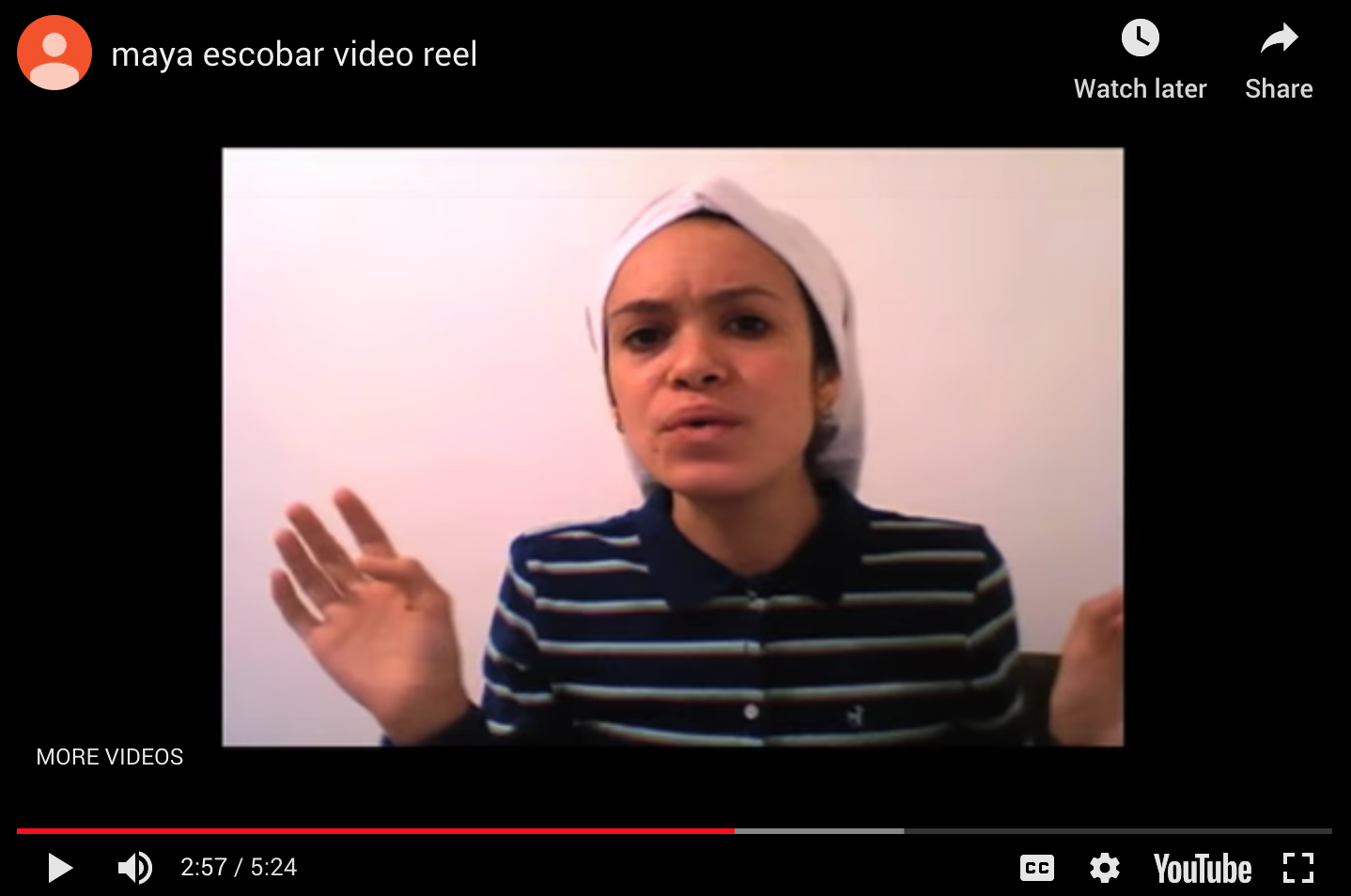
Frida Kahlo at the synagogue: Maya Escobar and the young Jewish-American Creationby David Sperber in Ma'arav Israeli Arts and Culture Magazine.translation by Shlomit NehoraiARTICLE IN SPANISH & HEBREWMaya Escobar is no doubt one of the 'hottest' things developing in the Jewish-American art scene. Escobar defines herself "dyslexic internet artist". And in order to view her work you need not wander far.Her work is mostly created in familiar internet format, and is most often displayed on Youtube. Escobar, daughter to a Jewish mother and Guatemalan father, defines her art work as ongoing personal anthropological-sociological research into the narrative language that uses contemporary media.[youtube=http://www.youtube.com/watch?v=3li_mT--f-A]The "Acciones Plasticas" work includes short films that present a series of convincing characters and monologues that deal with identity questions. In the first short film in the series she appears dressed up as the Mexican artist Frida Kahlo who became an icon within the feminist discourse. it is commonly argued that Kahlo had some Jewish roots. Escobar is dressed and made up as is famously attributed to Kahlo - the uni brow - while screaming "I am Frida Kahlo, you are Frida Kahlo, we are Frida Kahlo". In agitation or in ecstasy she tears her custom, messes up her hair, wipes her make up off of her face and returns to being herself. In another short film in the series she carries on with a monologue of a jewish orthodox woman. The text here is so exact that for a minute the line between irony and slapstick to deep seriousness is blurred. In another short film the stereotypical Latin female as a sexual sensual object is presented, when here too the subject is moving between embracing the stereotypes and breaking them. Escobar is presenting different episodes that she had experienced herself and that deal with her hybrid identity as a woman, as a Jew and as a Latin American.[youtube=http://www.youtube.com/watch?v=NNAxEUEE43Y]
Another work of Escobar is "my shtreimel" - a video-blog that is also presented on Youtube.In that piece appears a young man in his twentieths who sits in his room in front of a computer and talk about his Shabbat rituals. The monologue describes an amorphous jewish world in which jewishness lives and materializes without obligation to its institutions and mostly in personal frameworks. A central part in this world is self deprecation: The young man shows his beloved shtreimel and mentions that the shtreimel which looks like the traditional is actually a women's hat purchased at a thrift store.
In the work "eruv" (intermingling) Escobar relates to the fact that in Berlin there is no eruv even though there exists a vibrant jewish community. In a series of photographed interviews with the city's citizens she transforms the notion eruv - from a halachic-legal notion that creates a conversion of the public space into the private space, into a blending - the creation of a multiple of characters and worlds. The blending (eruv)transforms into a cultural concept that celebrates the different and the unique. The individuals create a splendid mosaic that assembles anew the "collective" as a social concept. The way Escobar deals with the subject is typical to the jewish-american art world that tends to transfer concepts from the practical halachic and transfer them to another world, and so they transform into a metaphor of the personal or social condition. The personal experience is significant to Escobar: " Like other jewish rituals, the Shabbat encompasses practicalities that materialize private condition in a private space. Except that the understanding of the private space and the public space is fluid and changes at all times. I think that it is very important that people celebrate their Shabbat as a pleasant experience, defined and personal. The Shabbat rituals evolve all the time - not as an unbending obligation that is transferred from generation to generation, but as a result of a simple choice of the individual to create to him/herself nice and pleasant Shabbat customs. We all have these kind of customs."The intercontinental use of the Internet gave birth to a generation of individuals who create for creation's sake, and the concept of art for art's sake gets that way a new meaning. The Internet media connects individuals and contributes to mutual influences between people who work separately in far away places. The young work on the Internet challenges the old definitions in relation to what is considered art and what isn't. Similarly, it adopts new presentation forms that are not the norm in the art world's mainstream, and breathes new air into the art field.The discussion into Escobar's work leads into a wider discussion about the differences between the Jewish thinking in the Israeli discourse into the new understanding of the American world view. The Jewish-artistic engagement in the United States is influenced by the introduction of new-age ideas into the center of the conversation, and is integrating into the effort to create a connection between contemporary culture and the traditional Jewish identity. Within the American-Jewish community there are signs of a move from an organized institutional Jewish expression into a unique and personal expression of the very personal experience. These artists reorganizing the traditions on their own terms, and in this way contributing not insignificantly to the definition of Jewish-American Non-Orthodox Modern-orthodox anew. The link between Jewish culture and Jewish identity to art occupies a central role in this conversation.The echoes of this tendency can be seen in Israel as well ( in the young Yiddish culture developing in Tel Aviv, for instance ), but generally there is still a deep disconnect between the dominant concepts in Israel and in the United States. In Israel it is common to connect between Judaism to an organized tradition and to a blood line that is based on a genetic continuity. On the other hand, many young Jewish-Americans marry outside their religion, but nevertheless see themselves as an integral part of the Jewish world and expect to not be expelled from it. As opposed to Israelis who experience their Jewishness in terms of disintegration that followed restoration, the Jewish-Americans create new branches where growth and rebirth metaphors fit them better.The joining of contemporary culture and art to Jewish creativity expresses itself in fashionable characteristics like tattoos, hip-hop music, Internet art and the like, and is often understood as the disconnect with the accepted binary dichotomy between holly and the common. That is why conservative bodies see these art forms as a dangerous provocation. These new cultural concepts interconnect during confrontational discussions with the old cultural concepts. Philologically speaking it can be said that borrowing symbols from one discipline to another interferes with the semiotic systems. In the Kabalistic vernacular it is said that the energy that is released during the friction that is created by the disintegration of the usual vessels - creates "new light".
Years of forced migration, displacement, and exile have inextricably linked the Jewish people to the notion of placelessness, and Judaism has become a "portable" faith that manifests itself through "imagined" connectivity engendered through ritual and scholarship.Employing the Talmudic tradition of non-linearity--that links together past, present, and future--this paper will trace public and private expressions of Jewishness and discuss how these expressions of identity contribute to an evolving discourse, one that I argue is essentially what Jewishness is.From the Talmud, to newspapers, to the blogosphere, Jews use these spaces as platforms for following Jewish law halacha while simultaneously engaging in dialog concerning the actions they are performing.In the first section of this paper I discuss how I have located myself within the virtual landscape of the web. Over the past three years I have spent a significant amount of constructing online identities. I will explain the process by which I create profiles on various social networking sites–join online groups, post blogs, images, videos and articles and tag myself with specific labels from the opposing and related discourses I wish to address. In the second section I will detail how my public positioning of three video blogs Blues Alchim, my shtreimel, and eruv stl labled with tags such as: halacha, modernorthodox, minhag, yeshivish, blogosphere, and eruv, helped set the conceptual foundation necessary for the piece Berlin's Eruv, which I will highlight in the third section of the paper.
Blues Alchim is a youtube video blog that I found on the hassidic reggae artist Matisyahu's youtube channel MatisyahuTV. Backstage at the House of Blues in Cleveland, Matisyahu stands in front of a group of young men, all waiting to pray while the singer records a video blog. Upon noticing a giant painting of John Belushi covering the room's eastern wall, Matis (as his friends call him) expresses concern that the group might transgress the Jewish legal prohibition against praying while facing an image. The singer decides to take matters into his own hands and announces to the group that they will construct a barrier that will block Belushi's face, allowing them to pray without fear of transgression.
my shtreimel also approached Jewish ritual observance with a similar humorous undertone. This video features a young man who sits alone in a room making a video blog about a personal ritual that he performs on the sabbath-- wearing a fake fur hat while citing obscure torah references. The description of the video reads "what is your minhag ? send in a reply."eruv stl is posted as a response to my shtreimel. An eruv is a rabbinically sanctioned demarcation of space that transforms public space into private space for the purposes of the Sabbath, allowing Orthodox Jews to carry in public places, a practice which is otherwise prohibited. Modern eruvs are often made of wire strung between utility poles, a gesture towards a "walled courtyard," indicating an enclosed, private space. In eruv stl two people drive around in a car with a map, trying to locate this barely visible boundary that surrounds Washington University's campus.Berlin's Eruv, is a conceptual project that I initiated last summer while studying in Berlin. Prior to that trip, I had never been to Germany- nor did I have any particular reservations about going or not going, but it seemed everyone else had their own opinion on the matter."Germany, how can you go there as a Jew?" "There are Jews in Germany? I thought they were all dead?" "You are so brave to go to Germany..."Ultimately people's projections as to my intentions for going to Germany became the filter through which I experienced Berlin. 1While I was in Berlin I conducted interviews with members of the community concerning the highly visible presence of the monuments and memorials commemorating Jewish life (death) have impacted their individual and communal Jewish identities. Other topics included: the notion of German Jews vs Jews living in Germany and how this differs from an American Jewish identity, their status as diaspora Jews and their relationship to Israel, their thoughts on the European Union, antisemitism and the widespread use of facebook as a mode of connection.The title of the piece Berlin's Eruv is a play on the fact that there is not actually an eruv in Berlin. Just as the eruv exists in the minds of the people who abide by it, Berlin's Eruv manifests itself through the conversations surrounding the idea of the piece. The interviews I conducted in Berlin relied on the presence of instituationalized markers of Jewish idenity, to give weight to the idea non-presence of the living Jewish community. On the web, Berlin's Eruv relies on it's framing within the Jewish Blogosphere in relationship to existing conversations concerning Jewish Identity.When presented at the Museum Berlin's Eruv has four parts: 1) an ipod which features selected interviews from members of Berlin's Jewish community, 2) a door sized silent looping projection of someone wandering aimlessly through the Memorial to the Murderd Jews of Europe, 3)to the right of the projection is a list of blue hyperlinks that represent the conversations that need to take place for the piece to manifest. 4) and a small monitor (at an off site location) that plays the three youtube video blogs: Blues Alchim, my shtreimel and, eruv stl.______________________________________________________1 Many of the young Jews that I interviewed in Berlin shared stories about their experiences with American Jews, who come to Berlin having been taught that there is no Jewish Life in Germany, and feel that it is their duty to reclaim that which has been taken from the Jewish people. I will explore this complicated claim territoriality further in this paper. Example of Hyperlinks that would be on wall of the kemperhttp://www.pipsworks.com/contact/projects/eruv.htmlhttp://berlinseruv.com/rabbijoshspinner/index.htmlhttp://youngisrael-stl.org/contactus.php#eruvhttp://www.jewishvirtuallibrary.org/jsource/Talmud/introerubin.htmlhttp://apikorostalmud.blogspot.com/http://www.dziga.com/idea/http://www.manuelherz.com/t-courtjester.htmlhttp://books.google.com/books?id=icnnz9-xhWgC&pg=PA34&dq=eruv&lr=&ei=91ZRSZTfApmUMaqU5cYE#PPA18,M1http://www.skulptur-projekte.de/kuenstler/wallinger?lang=enhttp://www.chabad.org/library/article_cdo/aid/257752/jewish/Eruv.htmhttp://www.chabad.org/library/article_cdo/aid/700456/jewish/What-is-an-Eruv.htmhttp://www.myjewishlearning.com/practices/Ritual/Shabbat_The_Sabbath/In_the_Community/Eruv/Women_and_Eruv.shtmlhttp://jewschool.com/2008/06/22/13661/internal-eruv-hatred/http://www.pipsworks.com/contact/projects/eruv.htmlhttp://berlinseruv.com/rabbijoshspinner/index.htmlhttp://youngisrael-stl.org/contactus.php#eruvhttp://www.jewishvirtuallibrary.org/jsource/Talmud/introerubin.htmlhttp://apikorostalmud.blogspot.com/http://www.dziga.com/idea/http://www.manuelherz.com/t-courtjester.htmlhttp://books.google.com/books?id=icnnz9-xhWgC&pg=PA34&dq=eruv&lr=&ei=91ZRSZTfApmUMaqU5cYE#PPA18,M1http://www.skulptur-projekte.de/kuenstler/wallinger?lang=enhttp://www.chabad.org/library/article_cdo/aid/257752/jewish/Eruv.htmhttp://www.chabad.org/library/article_cdo/aid/700456/jewish/What-is-an-Eruv.htmhttp://www.myjewishlearning.com/practices/Ritual/Shabbat_The_Sabbath/In_the_Community/Eruv/Women_and_Eruv.shtmlhttp://jewschool.com/2008/06/22/13661/internal-eruv-hatred/http://www.pipsworks.com/contact/projects/eruv.htmlhttp://berlinseruv.com/rabbijoshspinner/index.htmlhttp://youngisrael-stl.org/contactus.php#eruvhttp://www.jewishvirtuallibrary.org/jsource/Talmud/introerubin.htmlhttp://apikorostalmud.blogspot.com/http://www.dziga.com/idea/http://www.manuelherz.com/t-courtjester.htmlhttp://books.google.com/books?id=icnnz9-xhWgC&pg=PA34&dq=eruv&lr=&ei=91ZRSZTfApmUMaqU5cYE#PPA18,M1http://www.skulptur-projekte.de/kuenstler/wallinger?lang=enhttp://www.chabad.org/library/article_cdo/aid/257752/jewish/Eruv.htmhttp://www.chabad.org/library/article_cdo/aid/700456/jewish/What-is-an-Eruv.htmhttp://www.myjewishlearning.com/practices/Ritual/Shabbat_The_Sabbath/In_the_Community/Eruv/Women_and_Eruv.shtmlhttp://jewschool.com/2008/06/22/13661/internal-eruv-hatred/
Example of Hyperlinks that would be on wall of the kemperhttp://www.pipsworks.com/contact/projects/eruv.htmlhttp://berlinseruv.com/rabbijoshspinner/index.htmlhttp://youngisrael-stl.org/contactus.php#eruvhttp://www.jewishvirtuallibrary.org/jsource/Talmud/introerubin.htmlhttp://apikorostalmud.blogspot.com/http://www.dziga.com/idea/http://www.manuelherz.com/t-courtjester.htmlhttp://books.google.com/books?id=icnnz9-xhWgC&pg=PA34&dq=eruv&lr=&ei=91ZRSZTfApmUMaqU5cYE#PPA18,M1http://www.skulptur-projekte.de/kuenstler/wallinger?lang=enhttp://www.chabad.org/library/article_cdo/aid/257752/jewish/Eruv.htmhttp://www.chabad.org/library/article_cdo/aid/700456/jewish/What-is-an-Eruv.htmhttp://www.myjewishlearning.com/practices/Ritual/Shabbat_The_Sabbath/In_the_Community/Eruv/Women_and_Eruv.shtmlhttp://jewschool.com/2008/06/22/13661/internal-eruv-hatred/http://www.pipsworks.com/contact/projects/eruv.htmlhttp://berlinseruv.com/rabbijoshspinner/index.htmlhttp://youngisrael-stl.org/contactus.php#eruvhttp://www.jewishvirtuallibrary.org/jsource/Talmud/introerubin.htmlhttp://apikorostalmud.blogspot.com/http://www.dziga.com/idea/http://www.manuelherz.com/t-courtjester.htmlhttp://books.google.com/books?id=icnnz9-xhWgC&pg=PA34&dq=eruv&lr=&ei=91ZRSZTfApmUMaqU5cYE#PPA18,M1http://www.skulptur-projekte.de/kuenstler/wallinger?lang=enhttp://www.chabad.org/library/article_cdo/aid/257752/jewish/Eruv.htmhttp://www.chabad.org/library/article_cdo/aid/700456/jewish/What-is-an-Eruv.htmhttp://www.myjewishlearning.com/practices/Ritual/Shabbat_The_Sabbath/In_the_Community/Eruv/Women_and_Eruv.shtmlhttp://jewschool.com/2008/06/22/13661/internal-eruv-hatred/http://www.pipsworks.com/contact/projects/eruv.htmlhttp://berlinseruv.com/rabbijoshspinner/index.htmlhttp://youngisrael-stl.org/contactus.php#eruvhttp://www.jewishvirtuallibrary.org/jsource/Talmud/introerubin.htmlhttp://apikorostalmud.blogspot.com/http://www.dziga.com/idea/http://www.manuelherz.com/t-courtjester.htmlhttp://books.google.com/books?id=icnnz9-xhWgC&pg=PA34&dq=eruv&lr=&ei=91ZRSZTfApmUMaqU5cYE#PPA18,M1http://www.skulptur-projekte.de/kuenstler/wallinger?lang=enhttp://www.chabad.org/library/article_cdo/aid/257752/jewish/Eruv.htmhttp://www.chabad.org/library/article_cdo/aid/700456/jewish/What-is-an-Eruv.htmhttp://www.myjewishlearning.com/practices/Ritual/Shabbat_The_Sabbath/In_the_Community/Eruv/Women_and_Eruv.shtmlhttp://jewschool.com/2008/06/22/13661/internal-eruv-hatred/
There have been some wonderful submissions to togetherwehope.com. Here are some examples. Visit togetherwehope.com to share your hopes for the future.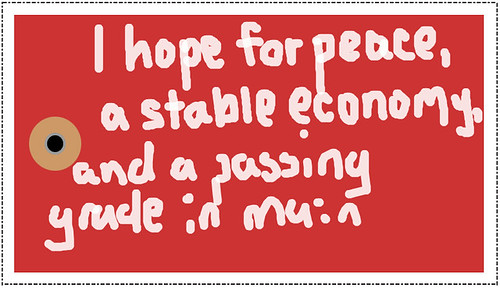
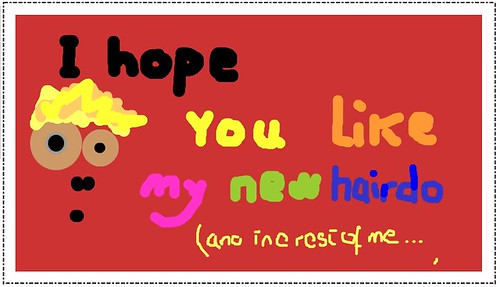
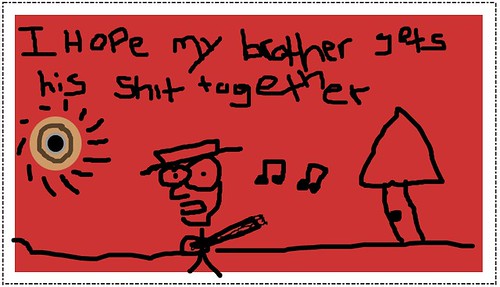
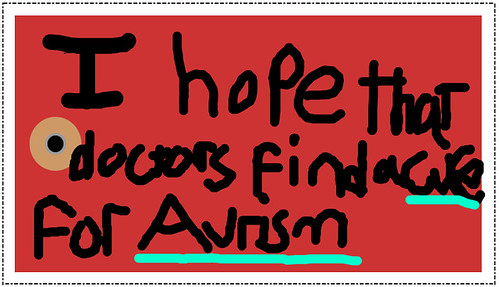
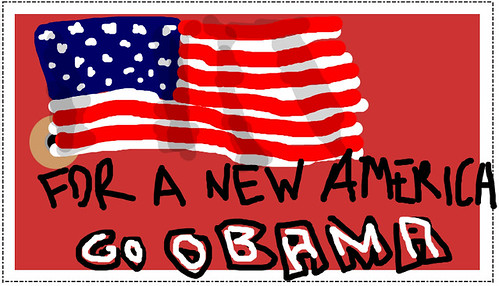
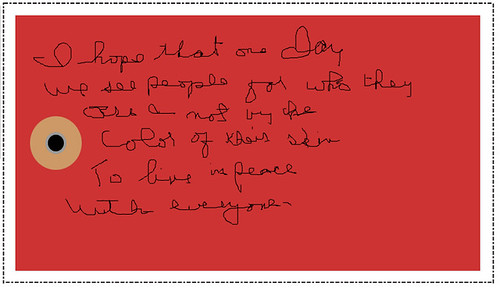
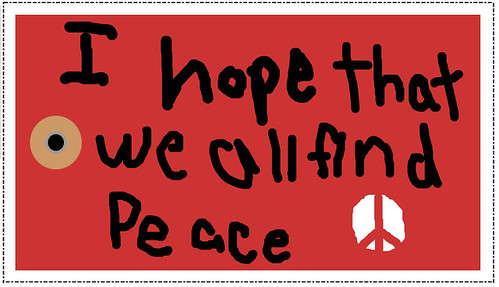
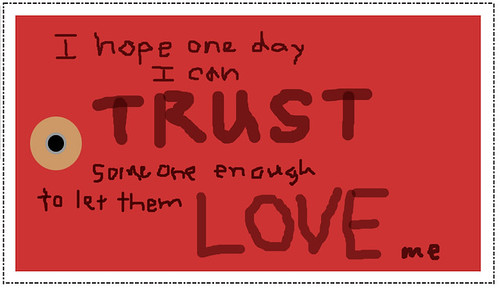
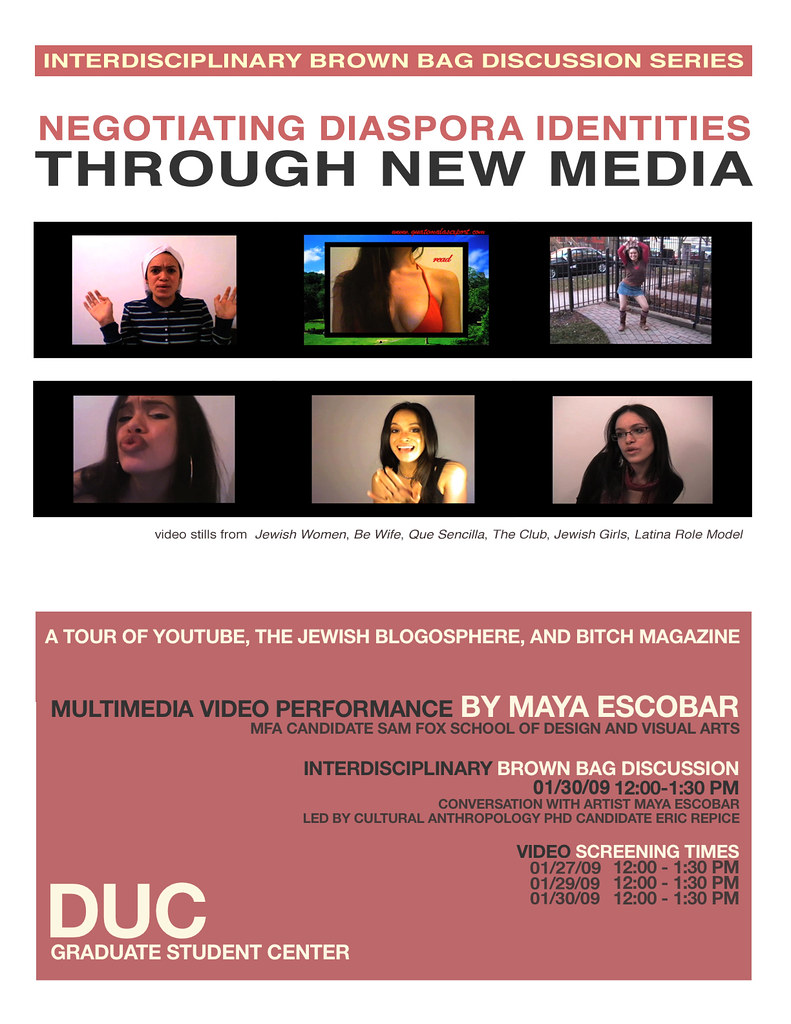 Join PhD Anthropology Candidate Eric Repice and MFA Candidate Maya Escobar in a brown bag lunch discussion concerning transnational, transcultural, and hybrid negotiations of identity through new media.How do these discussions vary between our fields?
Join PhD Anthropology Candidate Eric Repice and MFA Candidate Maya Escobar in a brown bag lunch discussion concerning transnational, transcultural, and hybrid negotiations of identity through new media.How do these discussions vary between our fields? Eric Repicefor more information on Eric Repice visit http://www.artsci.wustl.edu/~esrepice/homefor more information on Maya Escobar visit http://mayaescobar.com[youtube=http://www.youtube.com/watch?v=3li_mT--f-A][youtube=http://www.youtube.com/watch?v=G-GDmDcSH4g][youtube=http://www.youtube.com/watch?v=whLYM9o946w][youtube=http://www.youtube.com/watch?v=Vz2fhmRzCOA][youtube=http://www.youtube.com/watch?v=14bv0-dzMIc][youtube=http://www.youtube.com/watch?v=NNAxEUEE43Y]
Eric Repicefor more information on Eric Repice visit http://www.artsci.wustl.edu/~esrepice/homefor more information on Maya Escobar visit http://mayaescobar.com[youtube=http://www.youtube.com/watch?v=3li_mT--f-A][youtube=http://www.youtube.com/watch?v=G-GDmDcSH4g][youtube=http://www.youtube.com/watch?v=whLYM9o946w][youtube=http://www.youtube.com/watch?v=Vz2fhmRzCOA][youtube=http://www.youtube.com/watch?v=14bv0-dzMIc][youtube=http://www.youtube.com/watch?v=NNAxEUEE43Y]
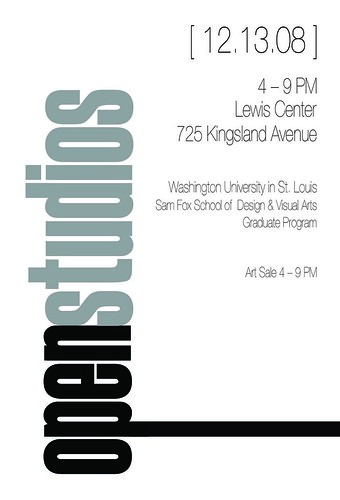 Washington University Graduate Open Studios and Art Sale Saturday, December 13th, 2008 Open Studios: 4-9 p.m. Lewis Center725 Kingsland_____________________________________________________________________Washington University MFA students are pleased to announce our Fall 2008 Open Studios and Art Sale, featuring work by more than 40 innovative young artists working in painting, printmaking, photography, sculpture, combined media, installation and video.From 4-9 our studios will be open to the public and artists will be present to answer questions and interact with visitors. This event presents a unique opportunity to experience the work of emerging artists outside the traditional gallery setting. The event will be accompanied by an art sale from 4-9:00 pm.The art sale will take place on the third floor of the MFA Building and will feature original works by MFA students. Payments may be made in cash, or by check with ID only. Proceeds will benefit the Washington MFA Student Organization and will be put towards the growth and development of the MFA program as well as to the individual artist.The Graduate Program has been flourishing at Washington University. Housed in the distinctive Lewis Center in the heart of University City, MFA students and faculty interact in a collaborative, organic setting, creating a program that is always evolving and pushing the boundaries of contemporary artistic practice. Please join us for this unique event.
Washington University Graduate Open Studios and Art Sale Saturday, December 13th, 2008 Open Studios: 4-9 p.m. Lewis Center725 Kingsland_____________________________________________________________________Washington University MFA students are pleased to announce our Fall 2008 Open Studios and Art Sale, featuring work by more than 40 innovative young artists working in painting, printmaking, photography, sculpture, combined media, installation and video.From 4-9 our studios will be open to the public and artists will be present to answer questions and interact with visitors. This event presents a unique opportunity to experience the work of emerging artists outside the traditional gallery setting. The event will be accompanied by an art sale from 4-9:00 pm.The art sale will take place on the third floor of the MFA Building and will feature original works by MFA students. Payments may be made in cash, or by check with ID only. Proceeds will benefit the Washington MFA Student Organization and will be put towards the growth and development of the MFA program as well as to the individual artist.The Graduate Program has been flourishing at Washington University. Housed in the distinctive Lewis Center in the heart of University City, MFA students and faculty interact in a collaborative, organic setting, creating a program that is always evolving and pushing the boundaries of contemporary artistic practice. Please join us for this unique event.
 November 19, 2008 -- Carianne Noga, a graduate student of art at Washington University, ties tags of hope onto a sculpture outside the University City Post-Office. Noga and fellow student Maya Escobar started soliciting people's hopes to place on the sculpture. (Christian Gooden/P-D)By Margaret GillermanST. LOUIS POST-DISPATCH11/29/2008UNIVERSITY CITY — Georgia O'Keeffe found inspiration in the light and shapes of New Mexico. Mary Cassatt found hers in mothers and children. Maya Escobar and Carianne Noga, two graduate students at Washington University's Sam Fox School of Art and Design, found inspiration for their latest project from the long lines on Election Day at a Ben and Jerry's ice cream shop in the Loop.There, on the sidewalk outside the shop, which was giving away scoops of ice cream to voters, the two women felt excitement and hope among voters. They said they found that same feeling across the street in the long line of voters waiting to vote at the Loop polling place."We wanted to continue that moment and not let it peak out," Noga said.Before the polls closed, they had begun to create their "I hope…" project.They first staked out a site: outside the University City Post Office at 561 Kingsland Avenue.They then provided people with bright red tags and paint markers for them to write down their hopes for a better future.The tags then are affixed to a permanent lattice wood sculpture already on site outside the Post Office."As difficult as it can be sometimes to voice our wishes and dreams, it can be strengthening," the artists say in explaining their mission. "We can be reminded of the rest of the world outside our own immediate concerns. In this period of great change and near infinite possibilities, it is time for us to voice our hopes."While the project is for all people, Escobar said it holds special meaning for young people."This is our moment to make a difference for our communities," Escobar said. "We need to be aware — of our national situation, of the economy."Many of the hopes expressed — most recorded anonymously — so far are noble and universal: "I hope for world peace" and "My hope is that hate is no longer."Some of the hopes are personal. "I hope to not fear death," wrote one.Others have a distinctly political bent: "I hope we get out of Iraq and don't go to war with Iran." And some are just fun, like the person hoping for "chocolate cake for dessert ..."A University City police officer named Hope — Reginald Hope — shared with them his own hope: for safety for police officers. A fellow officer was killed while on duty near the Loop last month.Washington University Chancellor Mark Wrighton gave his hope and "wishes for better health and greater prosperity for all."The artists also are encouraging people to submit their hopes online at togetherwehope.com.The existing sculpture outside the post office was designed in 2005 by an undergraduate architectural design studio taught by Carl Safe in the Washington University School of Architecture. University City resident Ethel Sherman had asked Safe to help create a sculpture in memory of her husband William Sherman, a Washington University biochemist who died about five years ago."It's strong like Bill and peaceful and quiet," she said. Sherman said she's thrilled about adding "I hope..." to it."This is an exciting time of change and hope," said Sherman, a retired psychologist and teacher who worked for 10 years at the Loop's Craft Alliance.The artists, both 24, come from family traditions of public service and political idealism."I grew up under the table of political meetings," says Escobar, remembering her childhood in Chicago. "My friends and I formed our first political organization when we were 11 — Students Against Child Oppression — on behalf of children in sweatshops in Mexico."Her mother is a school nurse, and her father, an educator, hosts a radio show in Chicago called "Si, Se Puede," which means "Yes, We Can." The program has been around since 1996.Noga grew up in the Washington, D.C., area and in Georgia. Her father is a psychiatrist at a state hospital, and her mother is a library director.Both artists are second-year graduate students in the two-year master's of fine arts program.The project will remain up through January. Later, the tags can be relocated to other sites and the online site will remain.University City has embraced the "I hope ..." project, according to city manager Julie Feier."It's an inspiring project," she said.
November 19, 2008 -- Carianne Noga, a graduate student of art at Washington University, ties tags of hope onto a sculpture outside the University City Post-Office. Noga and fellow student Maya Escobar started soliciting people's hopes to place on the sculpture. (Christian Gooden/P-D)By Margaret GillermanST. LOUIS POST-DISPATCH11/29/2008UNIVERSITY CITY — Georgia O'Keeffe found inspiration in the light and shapes of New Mexico. Mary Cassatt found hers in mothers and children. Maya Escobar and Carianne Noga, two graduate students at Washington University's Sam Fox School of Art and Design, found inspiration for their latest project from the long lines on Election Day at a Ben and Jerry's ice cream shop in the Loop.There, on the sidewalk outside the shop, which was giving away scoops of ice cream to voters, the two women felt excitement and hope among voters. They said they found that same feeling across the street in the long line of voters waiting to vote at the Loop polling place."We wanted to continue that moment and not let it peak out," Noga said.Before the polls closed, they had begun to create their "I hope…" project.They first staked out a site: outside the University City Post Office at 561 Kingsland Avenue.They then provided people with bright red tags and paint markers for them to write down their hopes for a better future.The tags then are affixed to a permanent lattice wood sculpture already on site outside the Post Office."As difficult as it can be sometimes to voice our wishes and dreams, it can be strengthening," the artists say in explaining their mission. "We can be reminded of the rest of the world outside our own immediate concerns. In this period of great change and near infinite possibilities, it is time for us to voice our hopes."While the project is for all people, Escobar said it holds special meaning for young people."This is our moment to make a difference for our communities," Escobar said. "We need to be aware — of our national situation, of the economy."Many of the hopes expressed — most recorded anonymously — so far are noble and universal: "I hope for world peace" and "My hope is that hate is no longer."Some of the hopes are personal. "I hope to not fear death," wrote one.Others have a distinctly political bent: "I hope we get out of Iraq and don't go to war with Iran." And some are just fun, like the person hoping for "chocolate cake for dessert ..."A University City police officer named Hope — Reginald Hope — shared with them his own hope: for safety for police officers. A fellow officer was killed while on duty near the Loop last month.Washington University Chancellor Mark Wrighton gave his hope and "wishes for better health and greater prosperity for all."The artists also are encouraging people to submit their hopes online at togetherwehope.com.The existing sculpture outside the post office was designed in 2005 by an undergraduate architectural design studio taught by Carl Safe in the Washington University School of Architecture. University City resident Ethel Sherman had asked Safe to help create a sculpture in memory of her husband William Sherman, a Washington University biochemist who died about five years ago."It's strong like Bill and peaceful and quiet," she said. Sherman said she's thrilled about adding "I hope..." to it."This is an exciting time of change and hope," said Sherman, a retired psychologist and teacher who worked for 10 years at the Loop's Craft Alliance.The artists, both 24, come from family traditions of public service and political idealism."I grew up under the table of political meetings," says Escobar, remembering her childhood in Chicago. "My friends and I formed our first political organization when we were 11 — Students Against Child Oppression — on behalf of children in sweatshops in Mexico."Her mother is a school nurse, and her father, an educator, hosts a radio show in Chicago called "Si, Se Puede," which means "Yes, We Can." The program has been around since 1996.Noga grew up in the Washington, D.C., area and in Georgia. Her father is a psychiatrist at a state hospital, and her mother is a library director.Both artists are second-year graduate students in the two-year master's of fine arts program.The project will remain up through January. Later, the tags can be relocated to other sites and the online site will remain.University City has embraced the "I hope ..." project, according to city manager Julie Feier."It's an inspiring project," she said.
[email protected] | 314-725-6758
[youtube=http://www.youtube.com/watch?v=ZcwPoFPdeVM]The polling lines were LONG in STL, I waited over 4 hrs to vote! But it was well worth it, I have never been more proud to be an american and to take part in such an important moment in history.The night of the elections, Carianne and I initiated our project together we hope with the help of our friend Becky Potts. We passed out red tyvek tags and asked people to write down their hopes for the future. We tried to encourage them to go beyond "I hope Obama wins" or I hope McCain wins".People wrote things ranging from "I hope I get good grades" to "I hope that we end the war in Iraq and do not go to war win Iran."Check out this website we created where you can submit your hopes online. We will make a tag for each hope submitted...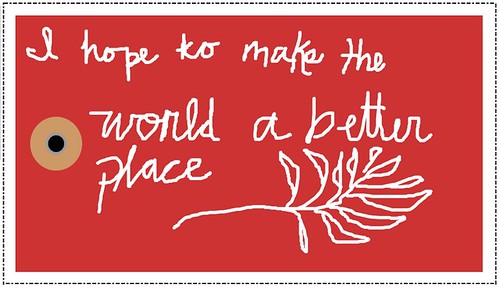
[youtube=http://uk.youtube.com/watch?v=AgHHX9R4Qtk]

 [youtube=http://uk.youtube.com/watch?v=wn0c-fiFNOc][youtube=http://uk.youtube.com/watch?v=V_Y8m2s3nnI][youtube=http://uk.youtube.com/watch?v=pHFYPad-cx8]
[youtube=http://uk.youtube.com/watch?v=wn0c-fiFNOc][youtube=http://uk.youtube.com/watch?v=V_Y8m2s3nnI][youtube=http://uk.youtube.com/watch?v=pHFYPad-cx8]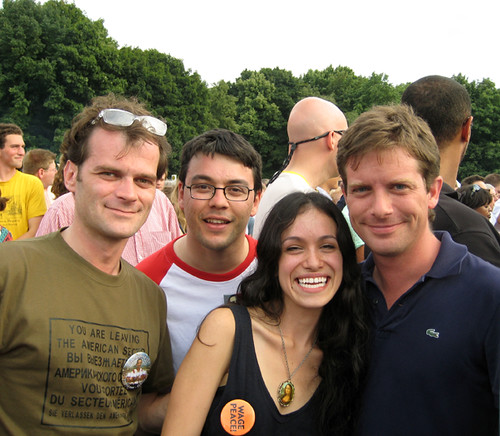 Marcello Saponaro, Andrea Mollica, Maya Escobar, Giuseppe CivatiPeople came from all over the world to see Obama!!! Here I am with 3 Italian friends I made who came to Berlin just for the rally. (giuseppe was my camera relief when my arms could no longer bear the weight...)
Marcello Saponaro, Andrea Mollica, Maya Escobar, Giuseppe CivatiPeople came from all over the world to see Obama!!! Here I am with 3 Italian friends I made who came to Berlin just for the rally. (giuseppe was my camera relief when my arms could no longer bear the weight...)